octane DODGE CHALLENGER 2013 3.G Owners Manual
[x] Cancel search | Manufacturer: DODGE, Model Year: 2013, Model line: CHALLENGER, Model: DODGE CHALLENGER 2013 3.GPages: 543, PDF Size: 3.04 MB
Page 380 of 543

General Information
This device complies with Part 15 of the FCC rules and
RSS 210 of Industry Canada. Operation is subject to the
following conditions:
•This device may not cause harmful interference.
• This device must accept any interference received,
including interference that may cause undesired op-
eration.
The TPM sensors are regulated under one of the follow-
ing licenses:
United States MRXC4W4MA4
Canada 2546A-C4W4MA4
FUEL REQUIREMENTS
3.6L Engine – If Equipped
This engine is designed to meet all emis-
sions regulations and provide excellent
fuel economy and performance when us-
ing high-quality unleaded “regular” gaso-
line having an octane rating of 87. The use
of premium gasoline is not recommended, as it will not
provide any benefit over regular gasoline in these
engines.
Light spark knock at low engine speeds is not harmful to
your engine. However, continued heavy spark knock at
high speeds can cause damage and immediate service is
required. Poor quality gasoline can cause problems such
as hard starting, stalling, and hesitations. If you experi-
ence these symptoms, try another brand of gasoline
before considering service for the vehicle.
378 STARTING AND OPERATING
Page 381 of 543
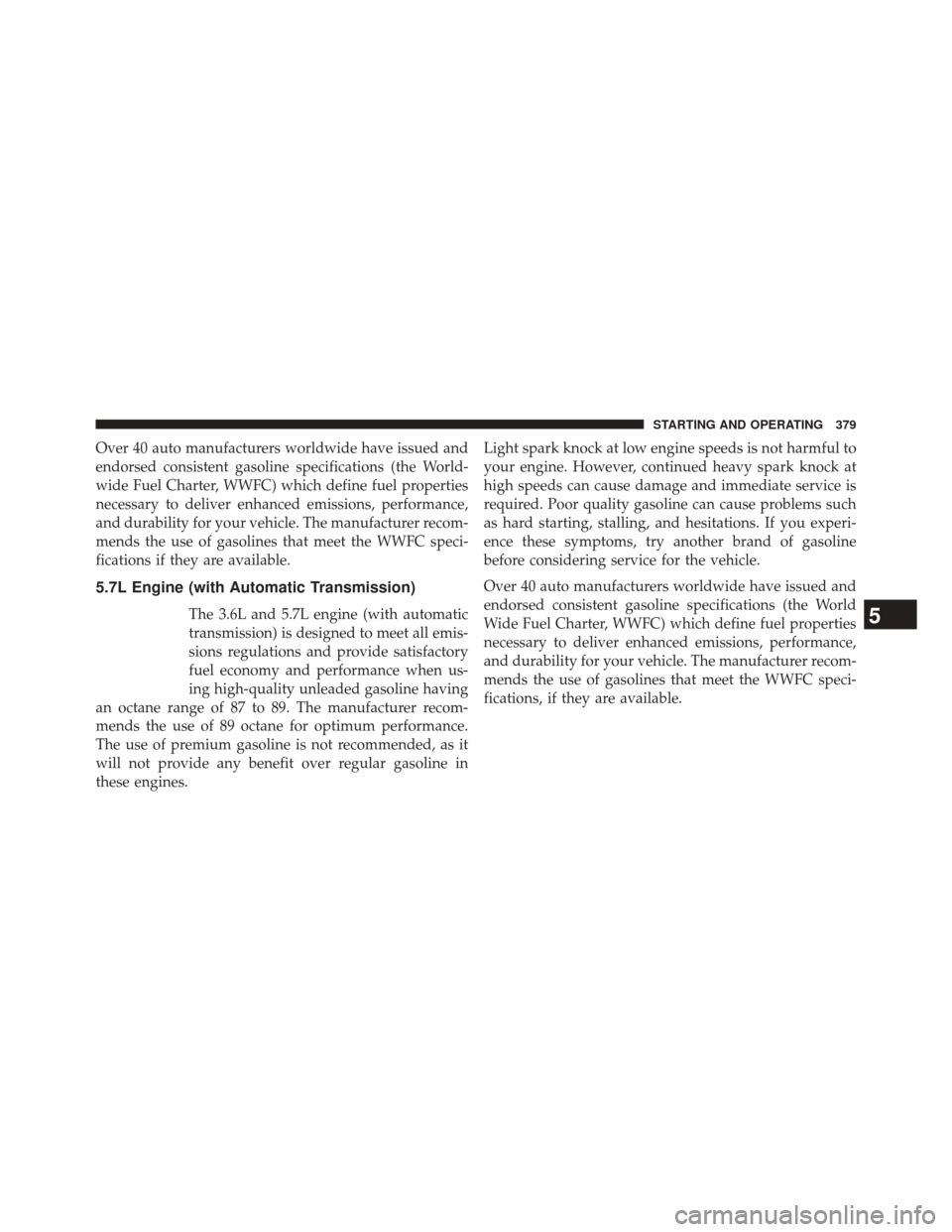
Over 40 auto manufacturers worldwide have issued and
endorsed consistent gasoline specifications (the World-
wide Fuel Charter, WWFC) which define fuel properties
necessary to deliver enhanced emissions, performance,
and durability for your vehicle. The manufacturer recom-
mends the use of gasolines that meet the WWFC speci-
fications if they are available.
5.7L Engine (with Automatic Transmission)
The 3.6L and 5.7L engine (with automatic
transmission) is designed to meet all emis-
sions regulations and provide satisfactory
fuel economy and performance when us-
ing high-quality unleaded gasoline having
an octane range of 87 to 89. The manufacturer recom-
mends the use of 89 octane for optimum performance.
The use of premium gasoline is not recommended, as it
will not provide any benefit over regular gasoline in
these engines. Light spark knock at low engine speeds is not harmful to
your engine. However, continued heavy spark knock at
high speeds can cause damage and immediate service is
required. Poor quality gasoline can cause problems such
as hard starting, stalling, and hesitations. If you experi-
ence these symptoms, try another brand of gasoline
before considering service for the vehicle.
Over 40 auto manufacturers worldwide have issued and
endorsed consistent gasoline specifications (the World
Wide Fuel Charter, WWFC) which define fuel properties
necessary to deliver enhanced emissions, performance,
and durability for your vehicle. The manufacturer recom-
mends the use of gasolines that meet the WWFC speci-
fications, if they are available.5
STARTING AND OPERATING 379
Page 382 of 543
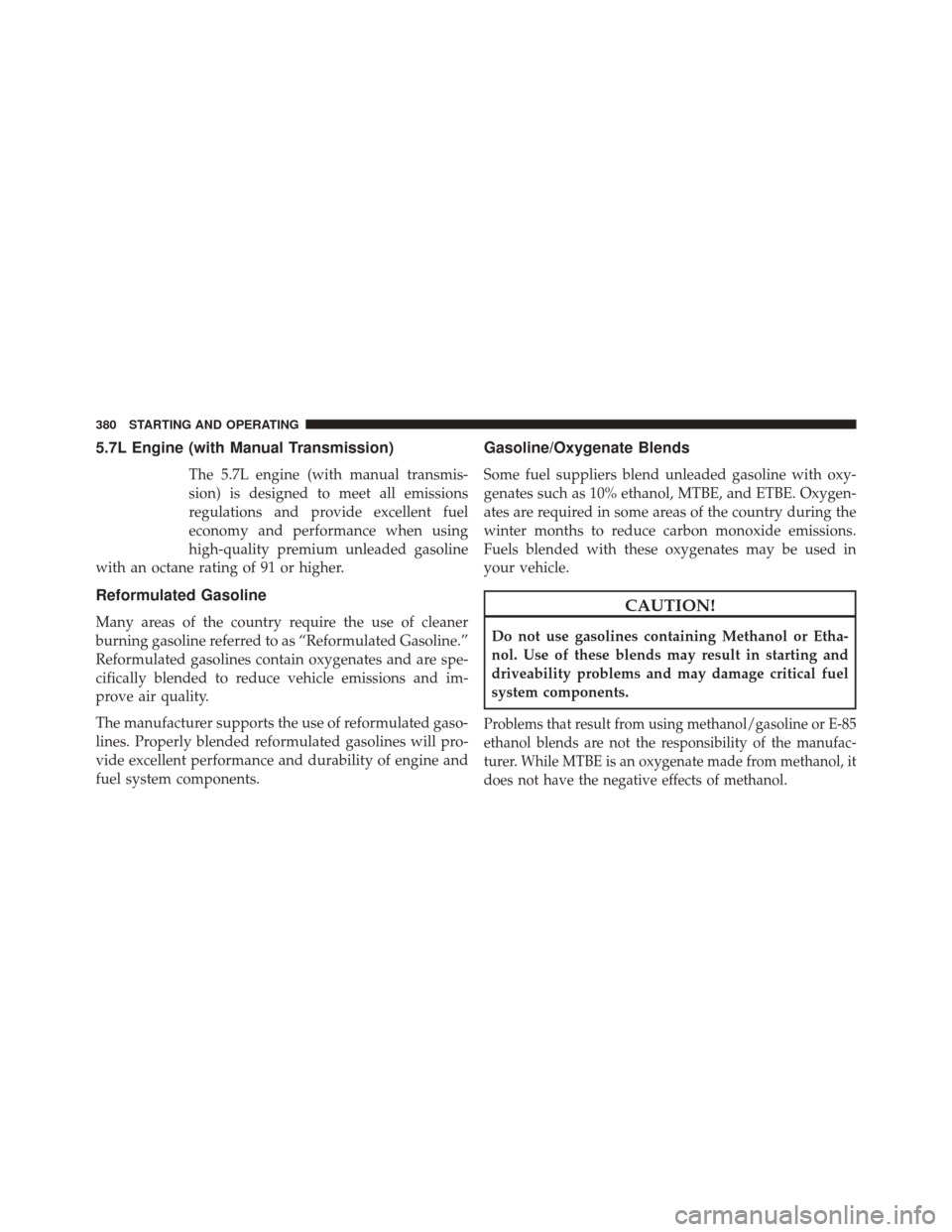
5.7L Engine (with Manual Transmission)
The 5.7L engine (with manual transmis-
sion) is designed to meet all emissions
regulations and provide excellent fuel
economy and performance when using
high-quality premium unleaded gasoline
with an octane rating of 91 or higher.
Reformulated Gasoline
Many areas of the country require the use of cleaner
burning gasoline referred to as “Reformulated Gasoline.”
Reformulated gasolines contain oxygenates and are spe-
cifically blended to reduce vehicle emissions and im-
prove air quality.
The manufacturer supports the use of reformulated gaso-
lines. Properly blended reformulated gasolines will pro-
vide excellent performance and durability of engine and
fuel system components.
Gasoline/Oxygenate Blends
Some fuel suppliers blend unleaded gasoline with oxy-
genates such as 10% ethanol, MTBE, and ETBE. Oxygen-
ates are required in some areas of the country during the
winter months to reduce carbon monoxide emissions.
Fuels blended with these oxygenates may be used in
your vehicle.
CAUTION!
Do not use gasolines containing Methanol or Etha-
nol. Use of these blends may result in starting and
driveability problems and may damage critical fuel
system components.
Problems that result from using methanol/gasoline or E-85
ethanol blends are not the responsibility of the manufac-
turer. While MTBE is an oxygenate made from methanol, it
does not have the negative effects of methanol.
380 STARTING AND OPERATING
Page 383 of 543
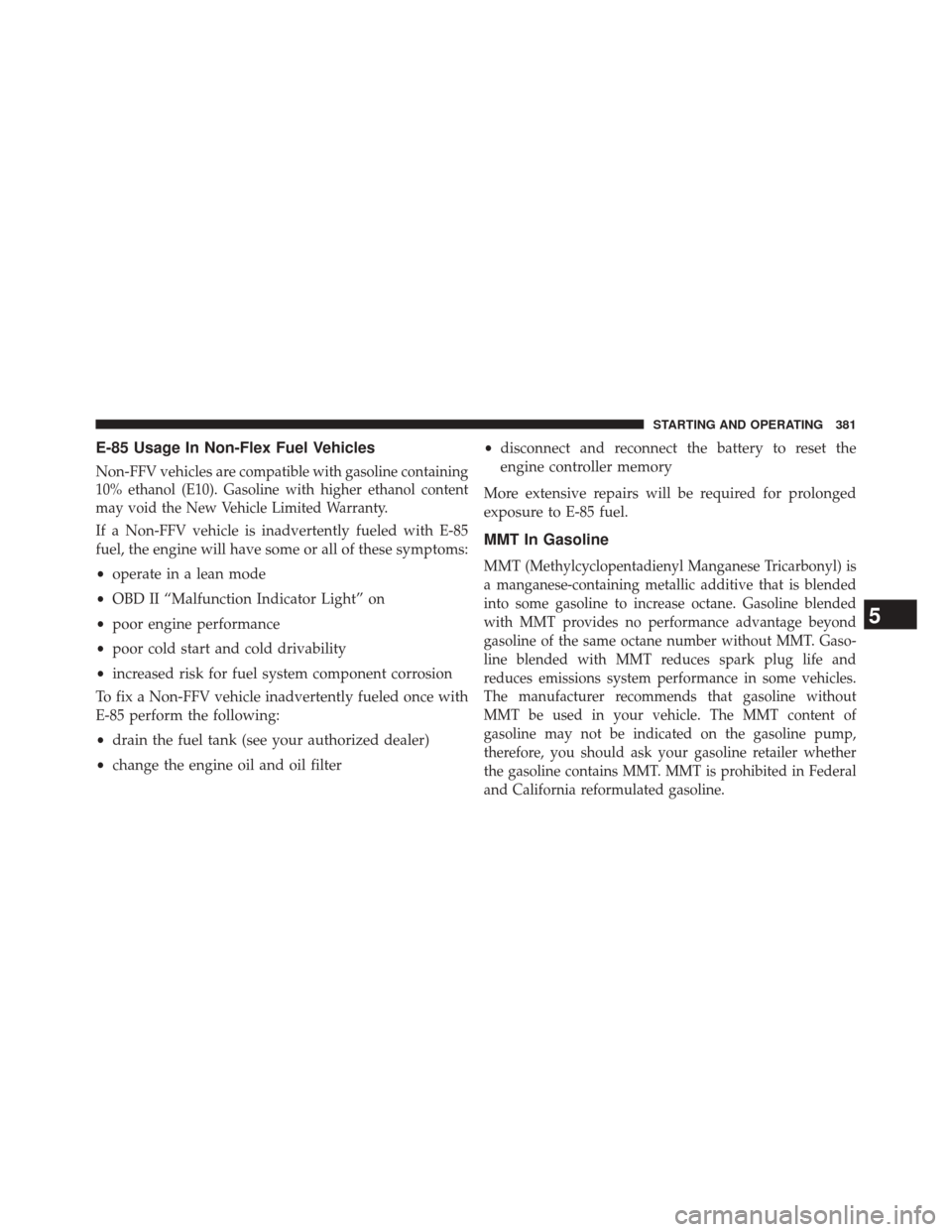
E-85 Usage In Non-Flex Fuel Vehicles
Non-FFV vehicles arecompatible with gasoline containing
10% ethanol (E10). Gasoline with higher ethanol content
may void the New Vehicle Limited Warranty.
If a Non-FFV vehicle is inadvertently fueled with E-85
fuel, the engine will have some or all of these symptoms:
• operate in a lean mode
• OBD II “Malfunction Indicator Light” on
• poor engine performance
• poor cold start and cold drivability
• increased risk for fuel system component corrosion
To fix a Non-FFV vehicle inadvertently fueled once with
E-85 perform the following:
• drain the fuel tank (see your authorized dealer)
• change the engine oil and oil filter •
disconnect and reconnect the battery to reset the
engine controller memory
More extensive repairs will be required for prolonged
exposure to E-85 fuel.MMT In Gasoline
MMT(Methylcyclopentadienyl Manganese Tricarbonyl) is
a manganese-containing metallic additive that is blended
into some gasoline to increase octane. Gasoline blended
with MMT provides no performance advantage beyond
gasoline of the same octane number without MMT. Gaso-
line blended with MMT reduces spark plug life and
reduces emissions system performance in some vehicles.
The manufacturer recommends that gasoline without
MMT be used in your vehicle. The MMT content of
gasoline may not be indicated on the gasoline pump,
therefore, you should ask your gasoline retailer whether
the gasoline contains MMT. MMT is prohibited in Federal
and California reformulated gasoline.
5
STARTING AND OPERATING 381
Page 384 of 543
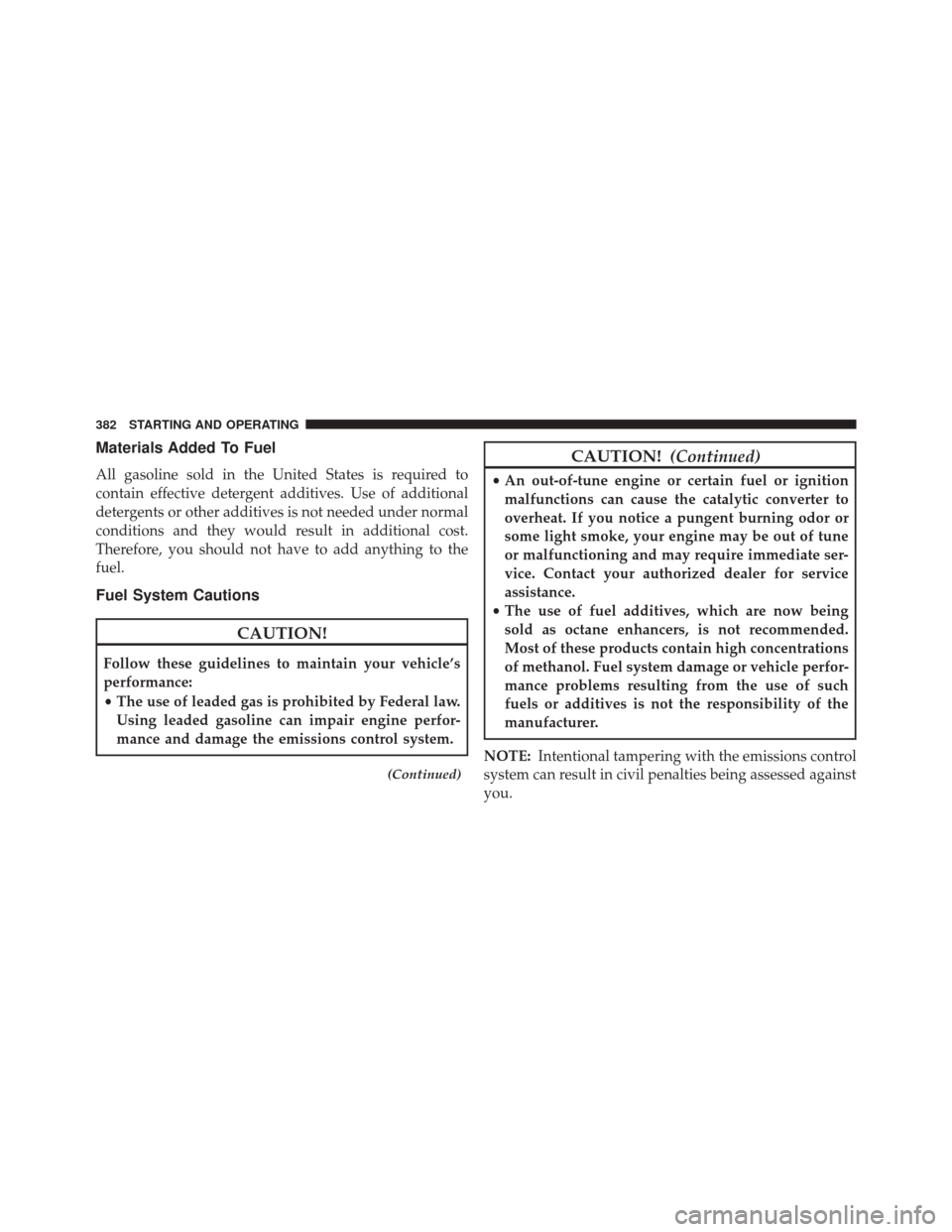
Materials Added To Fuel
All gasoline sold in the United States is required to
contain effective detergent additives. Use of additional
detergents or other additives is not needed under normal
conditions and they would result in additional cost.
Therefore, you should not have to add anything to the
fuel.
Fuel System Cautions
CAUTION!
Follow these guidelines to maintain your vehicle’s
performance:
•The use of leaded gas is prohibited by Federal law.
Using leaded gasoline can impair engine perfor-
mance and damage the emissions control system.
(Continued)
CAUTION! (Continued)
•An out-of-tune engine or certain fuel or ignition
malfunctions can cause the catalytic converter to
overheat. If you notice a pungent burning odor or
some light smoke, your engine may be out of tune
or malfunctioning and may require immediate ser-
vice. Contact your authorized dealer for service
assistance.
• The use of fuel additives, which are now being
sold as octane enhancers, is not recommended.
Most of these products contain high concentrations
of methanol. Fuel system damage or vehicle perfor-
mance problems resulting from the use of such
fuels or additives is not the responsibility of the
manufacturer.
NOTE: Intentional tampering with the emissions control
system can result in civil penalties being assessed against
you.
382 STARTING AND OPERATING
Page 499 of 543
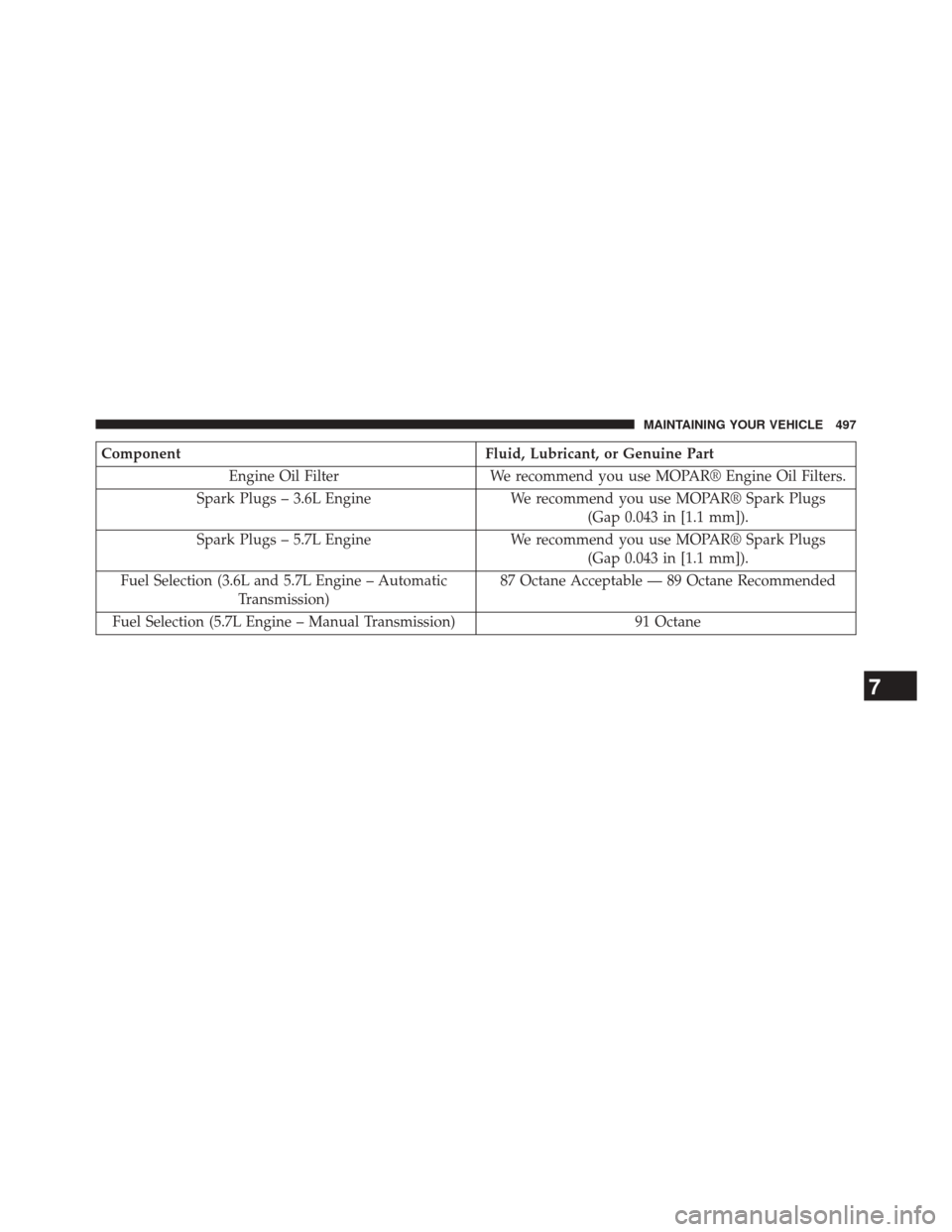
ComponentFluid, Lubricant, or Genuine Part
Engine Oil Filter We recommend you use MOPAR® Engine Oil Filters.
Spark Plugs – 3.6L Engine We recommend you use MOPAR® Spark Plugs
(Gap 0.043 in [1.1 mm]).
Spark Plugs – 5.7L Engine We recommend you use MOPAR® Spark Plugs
(Gap 0.043 in [1.1 mm]).
Fuel Selection (3.6L and 5.7L Engine – Automatic Transmission) 87 Octane Acceptable — 89 Octane Recommended
Fuel Selection (5.7L Engine – Manual Transmission) 91 Octane
7
MAINTAINING YOUR VEHICLE 497
Page 528 of 543
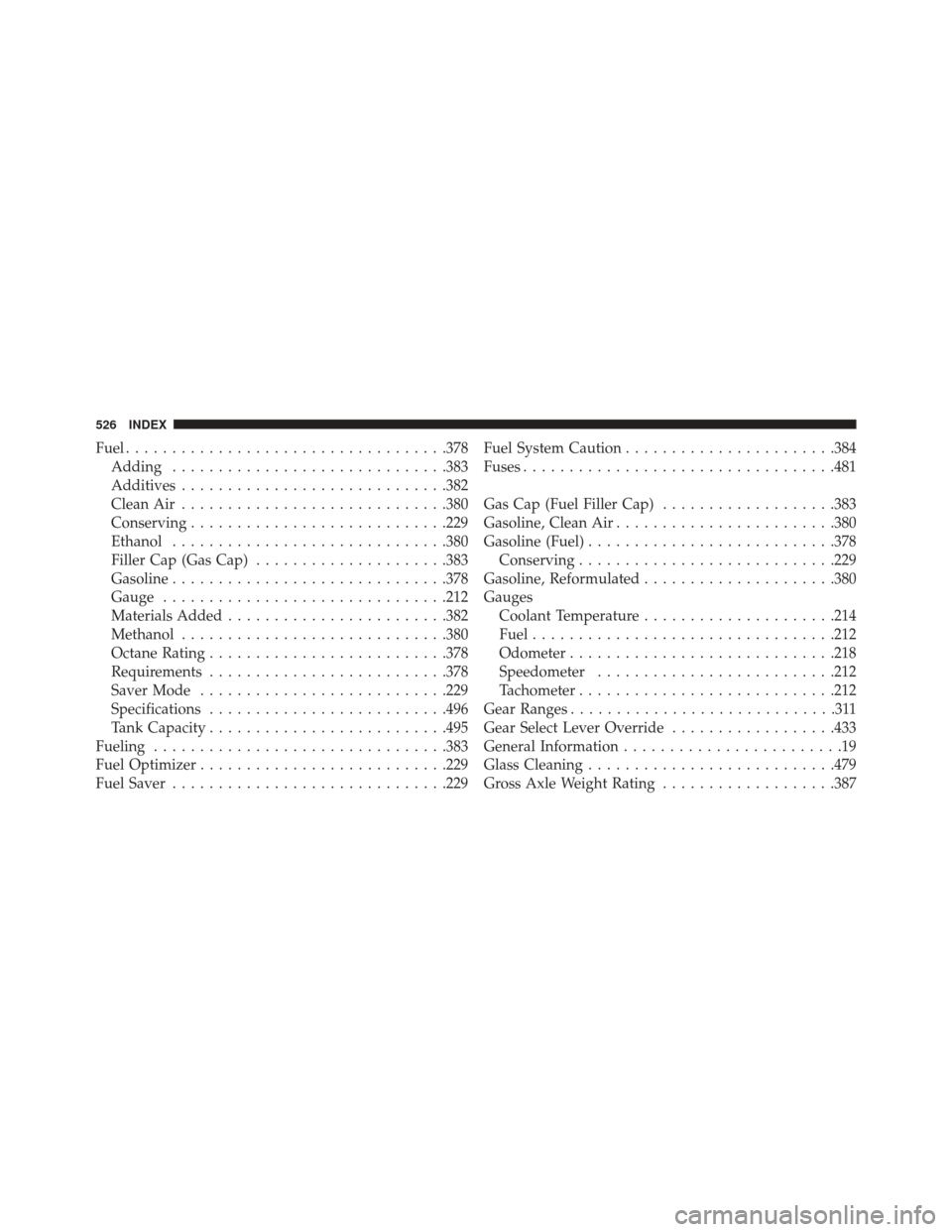
Fuel.................................. .378
Adding ............................. .383
Additives ............................ .382
Clean Air ............................ .380
Conserving ........................... .229
Ethanol ............................. .380
Filler Cap (Gas Cap) .....................383
Gasoline ............................. .378
Gauge .............................. .212
Materials Added ....................... .382
Methanol ............................ .380
Octane Rating ......................... .378
Requirements ......................... .378
Saver Mode .......................... .229
Specifications ......................... .496
Tank Capacity ......................... .495
Fueling ............................... .383
Fuel Optimizer .......................... .229
Fuel Saver ............................. .229Fuel System Caution
...................... .384
Fuses ................................. .481
Gas Cap (Fuel Filler Cap) ...................383
Gasoline, Clean Air ....................... .380
Gasoline (Fuel) .......................... .378
Conserving ........................... .229
Gasoline, Reformulated .....................380
Gauges Coolant Temperature .....................214
Fuel ................................ .212
Odometer ............................ .218
Speedometer ......................... .212
Tachometer ........................... .212
Gear Ranges .............................311
Gear Select Lever Override ..................433
General Information ........................19
Glass Cleaning .......................... .479
Gr
oss Axle Weight Rating ...................387
526 INDEX
Page 533 of 543
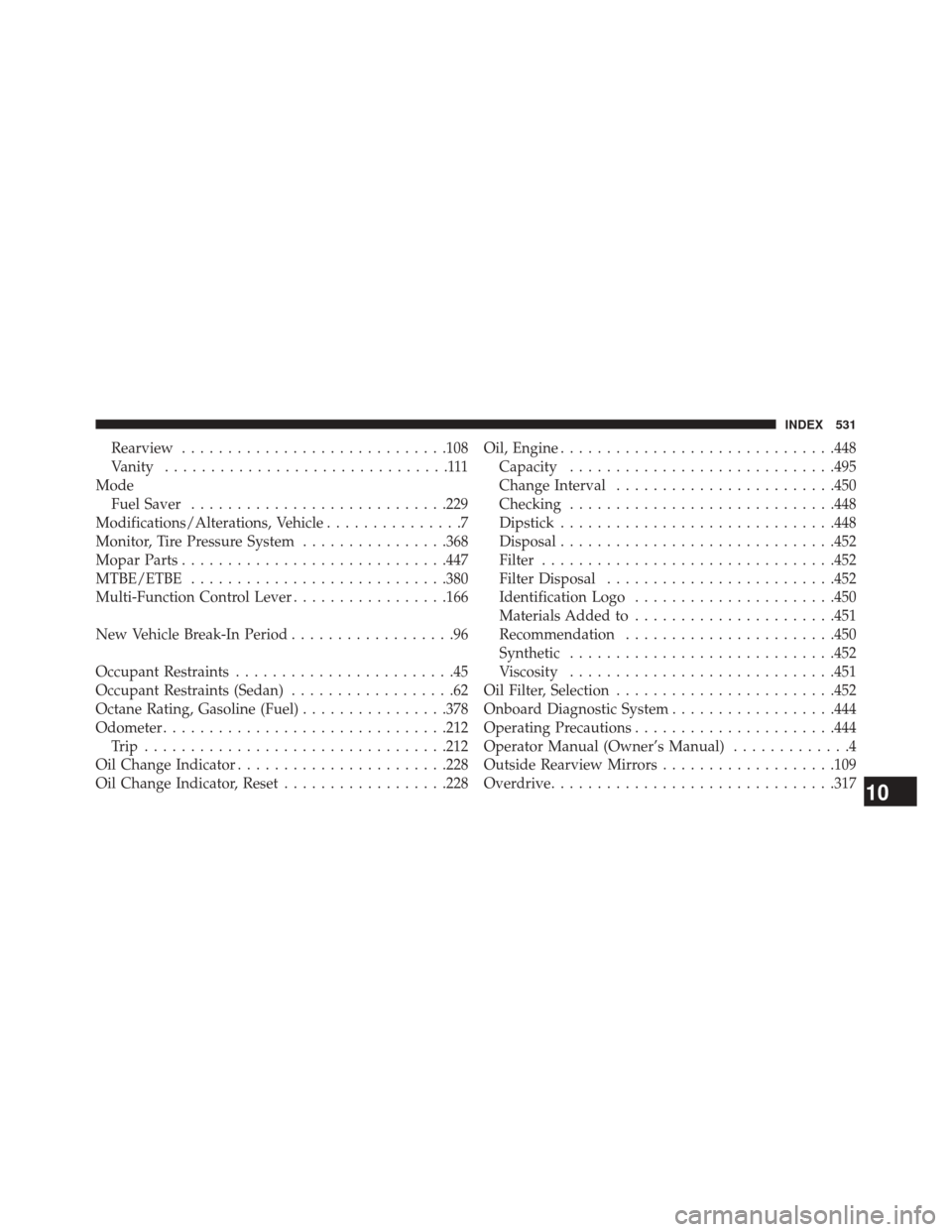
Rearview............................ .108
Vanity ...............................111
Mode Fuel Saver ........................... .229
Modifications/Alterations, Vehicle ...............7
Monitor, Tire Pressure System ................368
Mopar Parts ............................ .447
MTBE/ETBE ........................... .380
Multi-Function Control Lever .................166
New Vehicle Break-In Period ..................96
Occupant Restraints ........................45
Occupant Restraints (Sedan) ..................62
Octane Rating, Gasoline (Fuel) ................378
Odometer .............................. .212
Trip ................................ .212
Oil Change Indicator ...................... .228
Oil Change Indicator, Reset ..................228 Oil, Engine
............................. .448
Capacity ............................ .495
Change Interval ....................... .450
Checking ............................ .448
Dipstick ............................. .448
Disposal ............................. .452
Filter ............................... .452
Filter Disposal ........................ .452
Identification Logo ..................... .450
Materials Added to ..................... .451
Recommendation ...................... .450
Synthetic ............................ .452
Viscosity ............................ .451
Oil Filter, Selection ....................... .452
Onboard Diagnostic System ..................444
Operating Precautions ..................... .444
Operator Manual (Owner’s Manual) .............4
Outside Rearview Mirrors ...................109
Overdrive .............................. .317
10
INDEX 531